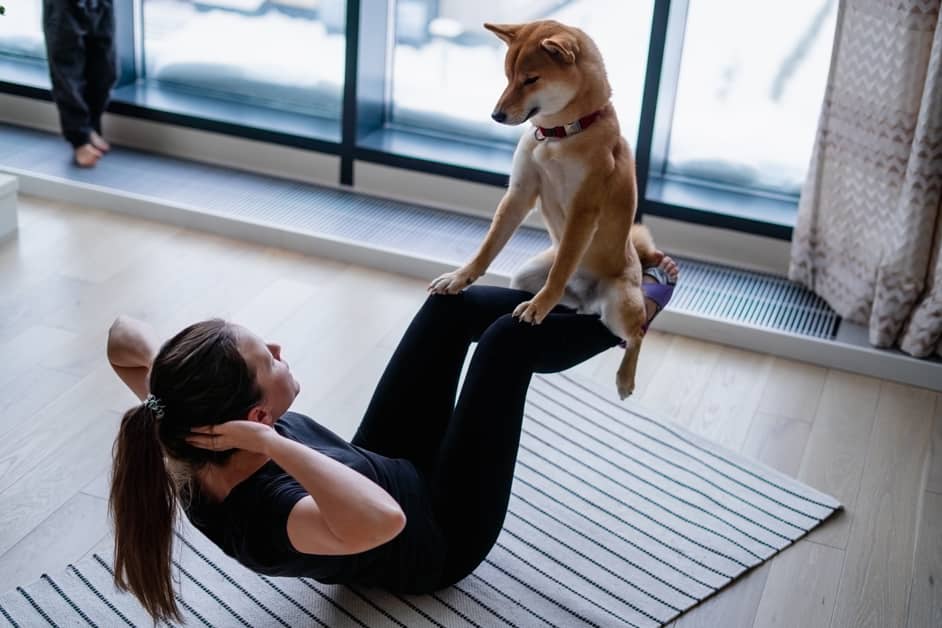Warm-up
Warming up is a must-do for basketball! It helps your body be ready for action and stops injuries. If you have knee pain, warm-ups can help make balance better by taking the pressure away from your knee joints.
Let’s see what exercises can make your warm up and balance ready for basketball:
Stretch your muscles
Muscle stretching is crucial in any warm-up. It helps with flexibility, lessens the risk of injuries, and boosts circulation. Focus on dynamic stretches, not static ones, for the best outcome. Dynamic involves moving your body and slowly increasing reach, speed, or both. In contrast, static involves holding a stretch for a time. Dynamic warms up your core, prepping your body for activity.
Dynamic exercises for warm-ups:
- Leg swings
- Hip circles
- Arm circles
- High knees
- Butt kicks
- Sumo squats
- Lunges
Take it slow, do each exercise with proper form for maximum benefit. Listen to your body – exercises causing pain or discomfort should be skipped, to avoid injury. Dynamic stretches are great for activating muscles and preventing injury during workouts.
Foam roll your muscles
Foam rolling is fab for prepping your muscles for basketball, and for improving balance with knee pain. It relaxes muscles, boosts flexibility, eliminates adhesions, and enhances circulation. This warm-up helps protect joints from stress, too!
For best results, roll each exercise 1-2 times on both sides of the body for 30 seconds each. Moderate pressure, and focus on the areas related to knee pain. Exercises include:
- Quads, calves & hamstrings
- Hip flexors
- Hip abductors
- Inner thighs
- Adductors
- Glutes
- IT band
- Shoulders/neck & chest
For a deeper understanding, talk to a coach or trainer.
When you’re done rolling and stretching, perform dynamic warm-up exercises, such as leg swings, walking lunges and lateral shuffles. This boosts mobility and reduces injury risk when playing basketball.
Strengthening Exercises
Strengthening exercises are super important for basketball players. They help improve balance and stability. Plus, these exercises can make the muscles around the knee stronger. This can lessen any knee pain while playing.
Do regular strengthening exercises and you can gain strength, stability and balance. You’ll also feel less knee pain.
Squats
Squats are great for balance and strength, even if you have knee pain. There are different types of squats for different goals. Start with bodyweight squats and as you get better, use weights like dumbbells or a barbell. Start with low weight and gradually increase. Goblet squats and trap bar squats can help if you have knee pain. Make sure your form is correct to avoid injury and get the best results.
Lunges
Lunges are a great form of exercise. They help with balance and endurance for basketball when you have knee pain.
To do a lunge:
- Stand with feet hip-width apart.
- Step one foot forward.
- Lower back knee to the ground.
- Sit back into a lunge so that both knees form 90-degree angles.
- Keep chest up and feet flat.
- Push off the ground using strength from both legs.
- Keep same leg forward for multiple reps, then switch.
For variations, do side lunges by stepping laterally towards one side. Maintain proper ankle alignment over each foot throughout.
Step-ups
Step-ups are great for leg strength, balance, and coordination. You can do them with different pieces of equipment. Always start with your feet flat on the floor and your body upright. Step up onto a raised surface like a step, bench, or box. Come back down to the beginning position. Do this 8-10 times.
- For extra difficulty, try single-leg step-ups or alternating heel taps.
- Move slowly and in control.
Balance Drills
Get your balance on the basketball court up, even with knee pain! Balance drills are a great way. You don’t need any extra equipment. Anywhere is fine. Improve your balance, decrease the chance of knee pain, and boost your overall performance. Let’s have a look at the best balance drills for basketballers with knee pain!
Single-leg balance
Single-leg balance drills help with body awareness and control, especially in the hips, core, and lower legs. They can improve balance, stability, proprioception and body alignment. You don’t need any equipment and they go well with other exercises. They become easier with practice and can help with everyday activities like walking and running.
Do the drills by standing on one leg for 30 seconds. Make sure your torso stays upright and you stay in control of the lower limb. Contract the muscles around your shin, thigh, and hip. To increase difficulty, stand on your toes or add arm motions or shift weight from side-to-side. The goal is to stand in place on one foot without sinking into your hips or needing to fix your posture.
Single-leg reach
Single-leg reach drills are fantastic for improving balance and strengthening lower body muscles. These drills can be altered to focus on basketball movements and reduce knee pain. If done correctly, they help you prepare for difficult balance sequences and single-leg movements while playing.
To do this drill:
- Stand with your feet together and arms out.
- Lift one leg and extend it straight in front.
- Push the opposite hip away, reaching for the sky with both arms.
- Maintain good posture as you lower the leg without touching the floor.
- Repeat 10 times before switching sides.
Make the exercise more difficult by balancing on a small foam cylinder or Bosu ball. If you have difficulty balancing or knee pain, keep one foot firmly on the ground. Remember to keep breathing as you do this drill – it will help keep your balance and concentration!
Single-leg balance with a medicine ball
Single-leg balance is great for strengthening basketball muscles and boosting overall stability and agility. You’ll need a medicine ball.
- Stand on one foot, with feet slightly wider than hip-width apart. Balance over the midfoot, arms out at shoulder height. Hold the medicine ball just above your head (or in front of your body if it’s too difficult).
- Extend one leg straight out in front of you. Take three deep breaths into your abdominal muscles and exhale as you bring your leg back to starting position. Keep good alignment with both shoulders pointing the same direction. Engage your glutes and abdominals to stay balanced while doing the exercise.
- Repeat up to 10 reps on each leg, for a total of three sets. To progress, start from a deeper squat or add more challenging balance drills, like closing your eyes.
Plyometric Exercises
Plyometrics exercises are awesome for upping your balance, agility, and explosiveness. Plus, they help make your legs stronger, helping with knee pain. Plyometrics involve jumps, hops, and bounding. This concentric and eccentric muscle action is fast and explosive.
In this article, we’ll talk about using plyometrics to better your balance and reduce knee pain. Plus, examples of exercises you can do to get started:
Single-leg hops
Single-leg hops are great for plyometric exercises to help improve your balance when playing basketball with knee pain. They’re easy to do and help strengthen the muscles surrounding your knees.
- Start in an upright standing position with both feet on the ground. Lift one leg so it’s out in front of you at a 45-degree angle. Bend the other leg behind you, ready to hop. Keep your core steady.
- Jump up and forward with two quick movements, shifting weight side to side. Use minimal movement of your arms to balance. When landing, bend slightly at the ankles and knees, and don’t lock any body parts.
- Repeat 10 times on one leg, then switch and repeat 10 times on the other. Rest for two minutes between sets.
- After, apply gentle pressure by kneeling and rolling over a foam roller or massage stick to help improve flexibility and reduce tension caused by plyometrics.
Single-leg jumps
Plyometric exercises, or “jump training,” are an exercise to make you stronger and faster. You use your body weight to produce power on the ground.
Single-leg jumps are one of these exercises. You don’t need much equipment for single-leg jumps. Just stand on one foot, with the other bent slightly. Put your hands on your hips for balance. Bend your working leg and jump up high. Then land softly on one foot. After that, open your legs wide and repeat.
Repetitions will depend on your fitness level. Many people start with a small number of reps and increase gradually. Beginners may want to try two-leg plyometrics first.
Box jumps
Box jumps are a great plyometric exercise to boost your lower body and core strength. It strengthens muscles, ligaments and tendons. Plyometric exercises are a type of dynamic stretching, perfect for athletes looking to up their power, speed and agility.
But remember – use correct form to avoid injury. Here’s how:
- Choose a box or step that matches your fitness level
- Stand with feet shoulder-width apart and toes pointing straight ahead
- Maintain neutral spine posture
- Bend arms at 90 degrees when you lunge down to the box
- Drive arms up as you jump over the box
- Land flat footed on the other side in a controlled way
- Always keep good form when performing this exercise.
Injury Prevention
Injuries can happen with any physical activity. To prevent them, it’s key to maintain good balance, especially for basketball players who might experience knee pain. This article will offer basics on how to improve balance and lower the risk of injury when playing basketball.
Stretch after your workout
Stretching after a workout is important, especially if you have knee pain. It can help reduce aches and boost your range of motion. Start slowly – hold each stretch for 30 seconds. You can repeat them several times during your warm-up and cool-down period.
Focus on your core muscles, such as your hip flexors, quads and hamstrings. These are vital for better balance. Consider using a foam roller after your workout. This can help relax tight muscles that can cause knee pain. Take your time with the foam roller – it may be painful initially, but it should feel better as your muscles loosen.
Avoid overtraining
When taking part in sports, it’s vital to be aware of the strain on your body. Whether you’re aiming to improve balance for basketball with knee pain, or any other activity, it’s key to avoid overtraining. If someone is having knee pain and trying to improve balance for basketball, they should take a break and get advice from a doctor or physical therapist before returning.
Avoiding overtraining will ensure players stay in good shape for games. Players should stick to organized training plans – warm ups, stretches, and strength conditioning programs. It’s also important to take regular breaks between practice and games for bodies to rest. Mindful technique is important too – proper form reduces the chance of injury due to incorrect posture or poor biomechanics.
Finally, coaches should make sure players stay hydrated by drinking lots of water throughout practice. This helps maintain proper muscle function during exercise sessions and games.
Wear supportive shoes
Good shoe support is must-have for those with knee pain. Your shoes should fit well and provide strong arch support to reduce pronation. Soles should have cushioning and shock absorption for protection from jumping, quick changes in direction, and cutting.
If off-the-shelf basketball shoes don’t work, get custom orthotics made. These are supportive and add stability to your knees when playing basketball.
Frequently Asked Questions
Q1: What exercises can I do to improve my balance with knee pain?
A1: You can try exercises such as single-leg balance, double-leg balance, and single-leg squats. You can also try standing on one foot while holding onto a wall or railing for support.
Q2: How often should I do these exercises?
A2: It is recommended to perform balance exercises 2-3 times a week. Make sure to start slowly and gradually increase the difficulty of the exercises as you become more comfortable.
Q3: Are there any special considerations for people with knee pain?
A3: Yes, if you have knee pain, it is important to do the exercises slowly and carefully so as not to put too much stress on the knee joint. Additionally, it is recommended to perform the exercises with the support of a wall or railing for additional stability.





